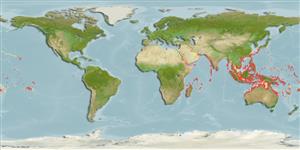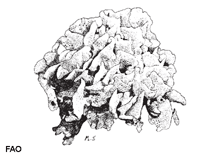Pavona decussata (Dana, 1846)
Cactus coral| Native range | All suitable habitat | Point map | Year 2050 |

|
| This map was computer-generated and has not yet been reviewed. |
| Pavona decussata AquaMaps Data sources: GBIF OBIS |
Classification / Names Common names | Synonyms | CoL | ITIS | WoRMS
Anthozoa | Scleractinia | Agariciidae
Environment: milieu / climate zone / depth range / distribution range Ecology
Reef-associated; depth range 0 - 40 m (Ref. 847). Tropical; 36°N - 29°S, 32°E - 137°W (Ref. 847)
Distribution Countries | FAO areas | Ecosystems | Occurrences | Introductions
Indo-Pacific.
Length at first maturity / Size / Weight / Age
Maturity: Lm ? range ? - ? cm
Short description Morphology
Small colonies are encrusting, and larger ones develop vertical plates that anastomose to form an interlocking matrix. The sides and edges of the plates are quite smooth. Individual corallites are tiny, superficial and run in irregular rows (Ref. 269).
Common in shallow to intermediate depths and may form colonies several meters in diameter and in height (Ref. 269). Common in shallow to intermediate depths (Ref. 269) in most reef habitats (Ref. 98471). Growth varies with water conditions: large, thin plates in clear shelter waters; thick plates in exposed areas; and minimal ridges form in high turbidity. The bivalve Barbatia helblingi was reported to be bysally attached, wedged between the plates of this coral (Ref. 130769).
Life cycle and mating behavior Maturity | Reproduction | Spawning | Eggs | Fecundity | Larvae
Members of the class Anthozoa are either gonochoric or hermaphroditic. Mature gametes are shed into the coelenteron and spawned through the mouth. Life cycle: The zygote develops into a planktonic planula larva. Metamorphosis begins with early morphogenesis of tentacles, septa and pharynx before larval settlement on the aboral end.
Main reference
References | Coordinator | Collaborators
Hodgson, G. 1998. (Ref. 269)
IUCN Red List Status (Ref. 130435)
Vulnerable (VU) (A4c); Date assessed: 03 January 2008
CITES status (Ref. 108899)
Appendix II: International trade monitored
CMS (Ref. 116361)
Not Evaluated
Threat to humans
Human uses
| FishSource |
Tools
More information
Internet sources
BHL | BOLD Systems | CISTI | DiscoverLife | FAO(Publication : search) | Fishipedia | GenBank (genome, nucleotide) | GloBI | Gomexsi | Google Books | Google Scholar | Google | PubMed | Hexacorallians of the World | Tree of Life | Wikipedia (Go, Search) | Zoological Record
Estimates based on models
Preferred temperature
(Ref. 115969): 24.7 - 29.1, mean 28 (based on 1136 cells).
Price category
(Ref. 80766):
Unknown.



